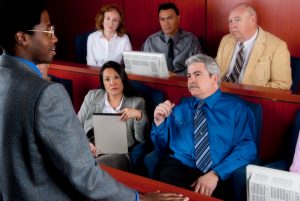Navigating the Intricacies of Test Presentations: Tips for Seamless Distribution and Compelling Disagreements
In the realm of lawful procedures, the art of test presentation stands as a vital factor of success. The intricacies integral in test discussions call for a fragile equilibrium of technique, skill, and finesse.

Understanding Trial Goals
To properly browse a trial, it is essential to have a clear understanding of the goals that require to be attained. Prior to stepping right into the court room, legal teams should define their goals and preferred results. These purposes work as leading principles throughout the trial, shaping approaches and affecting decision-making procedures.
Recognizing test objectives involves an extensive analysis of the situation, legal precedents, and the client's benefits. Trial Presentations. It calls for a thorough exam of the realities, recognizing vital concerns, and preparing for prospective difficulties. By setting particular and measurable objectives, attorneys can tailor their arguments and discussions to line up with the desired results
In addition, a clear grip of test purposes allows legal teams to focus on evidence, witnesses, and legal debates properly. It permits the development of a coherent story that resonates with the discretionary, reinforcing the general case discussion.

Organizing Proof Efficiently
Having a clear understanding of trial purposes lays the foundation for arranging evidence properly in legal proceedings. By aligning the discussion of evidence with the wanted results of the trial, legal groups can enhance their arguments and improve their persuasiveness.
Another crucial element in organizing proof properly is developing a logical flow. Providing evidence in a consecutive and meaningful fashion can help construct a compelling story that supports the legal debates being made. Additionally, making use of visual aids such as graphes, charts, or timelines can even more boost the organization of evidence and help in making clear complicated partnerships or sequences of events.
Furthermore, making sure that all proof presented is pertinent and admissible to the situation is crucial. Unimportant or inadmissible proof can interfere with the toughness of the argument and potentially hurt the credibility of the providing event. A meticulous review and selection process should be undertaken to include only the most legitimately audio and impactful proof in the trial presentation.
Crafting Persuasive Narratives
Crafting engaging stories plays a crucial duty in offering persuasive arguments during legal procedures. A well-crafted narrative has the power to mesmerize the audience, evoke emotions, and eventually persuade the decision for the here and now celebration. When building a story for a test presentation, it is important to develop a clear storyline that highlights bottom lines and links them in a meaningful way. Begin by describing the truths of the situation in a compelling fashion, ensuring that the series of occasions is simple to comply with. Introduce characters successfully, supplying background information that aids the target market recognize their motivations and actions. Furthermore, integrating vibrant descriptions and interesting language can bring the narrative to life, making it more remarkable for the court and jury. By weaving together proof, statement, and legal debates right into a influential and cohesive narrative, attorneys can effectively promote for their customers and boost the possibility of a favorable end result in the court.
Grasping Aesthetic Help
Effective use aesthetic aids is crucial to boosting the impact and clearness of test presentations. Visual aids, when made use of strategically, have the power to simplify complicated details, reinforce bottom lines, and leave a lasting perception on the discretionary. To master visual aids in trial discussions, it is critical to guarantee that they are clear, concise, and appropriate to the disagreements being made.
When including aesthetic aids, such as charts, pictures, charts, or timelines, into a test discussion, it blog here is necessary to keep them visually appealing yet professional. The visuals ought to complement the verbal arguments, offering a visual representation of the info being talked about without overwhelming the audience with unnecessary information.
In addition, exercising with the aesthetic aids in advance is critical to ensure a smooth distribution throughout the trial. Familiarizing oneself with the content, transitions, and here are the findings timings of each aesthetic help can assist keep the circulation of the discussion and stop technical glitches that might emerge.
Supplying Impactful Closing Disagreements
A compelling closing argument works as the end result of a test presentation, encapsulating the core story and convincing the court and court towards a favorable choice. To provide an impactful closing argument, it is crucial to succinctly summarize bottom lines, highlight the strengths of your instance, and attend to any weak points in a calculated manner. Begin by describing the main debates that support your client's setting, emphasizing why the proof provided throughout the test supports your narrative. It is necessary to produce a sense of communication and clarity, leading the discretionary towards the preferred conclusion.
Additionally, including psychological allure can further strengthen your closing disagreement. Eventually, a well-crafted closing disagreement need to leave a long-term perception, engaging the court and court to rule in your customer's support.
Verdict
Finally, understanding test discussions entails understanding objectives, organizing proof, crafting stories, making use of aesthetic help, and providing impactful closing disagreements. By carrying out these methods successfully, attorneys can provide their situation perfectly and make compelling debates in the court get more room. It is critical to browse the intricacies of trial presentations with accuracy and ability to accomplish success in legal process.
By straightening the discussion of evidence with the desired end results of the test, legal teams can enhance their disagreements and enhance their persuasiveness (Trial Presentations). To understand aesthetic aids in test discussions, it is important to guarantee that they are clear, concise, and pertinent to the debates being made
A compelling closing argument offers as the conclusion of a trial discussion, encapsulating the core story and convincing the judge and court towards a desirable choice. Begin by outlining the major disagreements that support your customer's position, stressing why the evidence offered throughout the trial sustains your narrative.In conclusion, grasping test presentations entails comprehending objectives, arranging proof, crafting narratives, utilizing visual help, and providing impactful closing debates.
Comments on “From Principle to Court: Actions to Develop Effective and Persuading Trial Presentations”